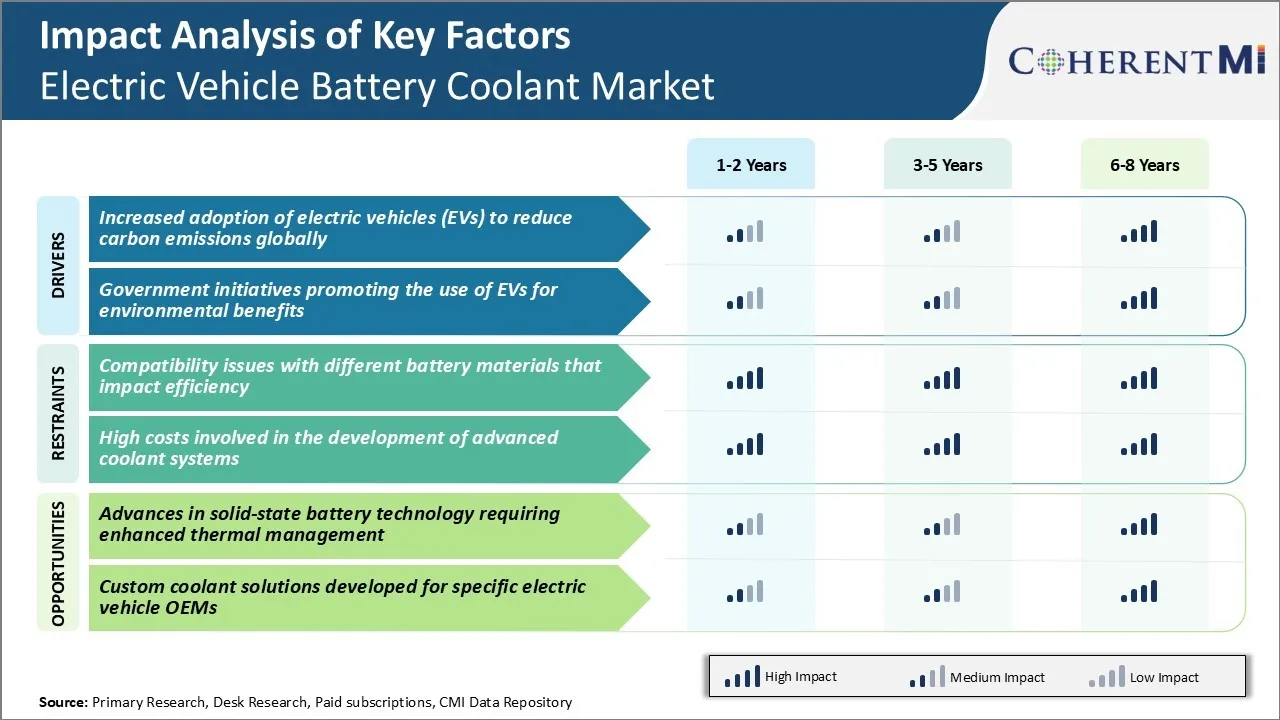Electric Vehicle Battery Coolant Market Trends
Market Driver - Increased Adoption of Electric Vehicles to Reduce Carbon Emissions Globally
Transportation sector is recognized as a major contributor to carbon emissions today. This has put the spotlight on electric vehicles that have zero direct emissions. Countries have set ambitious targets to transition to electric mobility to reduce dependence on oil imports and curb greenhouse gas emissions from vehicles.
With growing fleet of EVs on the road, installed base of lithium-ion batteries powering these vehicles will continue expanding over the coming years. With batteries making up nearly half the cost of an EV, effective thermal management of these large and energy dense battery packs becomes critical for ensuring optimal performance and prolonging their lifespan.
This burgeoning electric mobility revolution will likely drive strong demand for more sophisticated and efficient battery cooling systems for electric vehicles. Advance cooling solutions will play a vital role in encouraging continued uptake of battery-powered vehicles and faster energy transition globally. Consequently, this is expected to drive growth of the electric vehicle battery coolant market in the coming years.
Market Driver - Government Initiatives Promoting the Use of Electric Vehicles for Environmental Benefits
Recognizing transportation's outsized carbon footprint, countries are stepping up policy support to accelerate adoption of electric mobility. Many nations have introduced purchase incentives like tax rebates and non-monetary incentives. Several cities offer other benefits such as free charging at public stations and no registration fee or road tax for EVs. Many governments provide subsidies for production and marketing of EVs.
Policy driven adoption aligns with national goals to diversify energy sources, boost energy security and transition to a greener transport system. Developed nations are leading the push for electric mobility while emerging countries are catching up through supportive policy ecosystems. A robust policy framework has accelerated the push towards low or zero emission vehicles in nations committed to curbing environmental impact of transportation.
Continued focus on measures promoting EVs, should translate into higher penetration rates and transform the global vehicle landscape. This signals positive growth prospects for the electric vehicle battery coolant market.

Market Challenge - Compatibility Issues with Different Battery Materials that Impact Efficiency
One of the key challenges faced in the electric vehicle battery coolant market is the compatibility issues between different battery materials and coolants. Battery chemistries vary significantly across manufacturers with different anode and cathode combinations being used.
Finding a universal coolant that can efficiently manage heat transfer across all these different battery materials has been difficult. Incompatibility can cause issues like increased impedance between electrodes, decay of active materials and premature capacity loss over battery cycling.
Extensive research and testing are required to analyze how a particular electric vehicle battery coolant interacts at a chemical level with each battery composition. Selecting appropriate formulations of electric vehicle battery coolants without compromising on efficiency also remains a challenge given the technology and composition changes in EV batteries slated for the future. This is expected to create significant challenges for players in the electric vehicle battery coolant market.
Market Opportunity - Advances in Solid-state Battery Technology Requiring Enhanced Thermal Management
One of the major opportunities for players in the electric vehicle battery coolant market lies in advances being made in solid-state battery technologies. Solid-state batteries offer higher energy densities and better safety compared to traditional lithium-ion batteries. However, they also generate more heat during operation due to characteristics like higher electron and ion conductivity.
As solid-state batteries move closer to commercialization, there will be a growing need for developing innovative coolant solutions that can maintain ideal operating temperatures under higher heat loads. Leading battery and auto companies in the electric vehicle battery coolant market have been investing heavily in solid state technology research. It is expected to cater to the spurring demand for advanced coolants featuring higher heat transfer capabilities.
With existing thermal solutions, manufacturers in the electric vehicle battery coolant market have an opportunity to engineer products customized for emerging solid state battery chemistries and requirements.